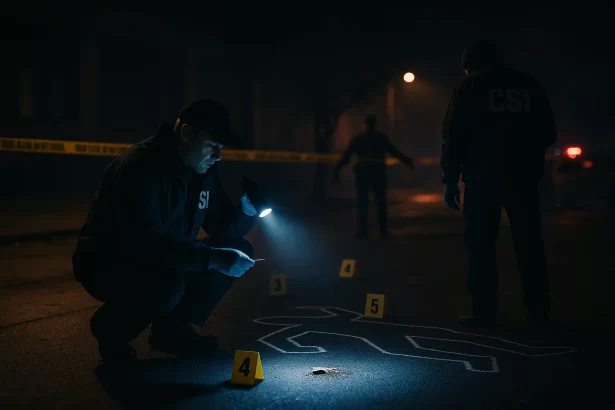Cast-off trails refer to the distinctive patterns or paths cast-off blood creates as it is projected or transferred from a source during motion. These patterns are crucial to bloodstain pattern analysis (BPA) in forensic science and crime scene investigations. Cast-off trails provide essential insights into the dynamics of a crime, including the direction, angle, and sequence of bloodstains produced by a moving source.
Key points about cast-off trails include:
1. Formation: Cast-off trails are formed when an object or individual with blood on them moves within the crime scene. As the blood-covered source moves, it sheds or casts off droplets or spatters of blood onto nearby surfaces or objects.
2. Characteristic Patterns: The patterns of cast-off trails are characterized by the shape, size, and arrangement of bloodstains. These patterns can vary based on factors such as the speed of motion, the angle of impact, and the surface onto which the blood is projected.
3. Bloodstain Pattern Analysis: Forensic experts use the analysis of cast-off trails and other bloodstain patterns to reconstruct the events leading to their formation. By studying the trails, investigators can determine the source’s movement, the number of cast-off events, and the potential presence of multiple sources.
4. Crime Scene Reconstruction: Cast-off trails are crucial in reconstructing crime scenes, particularly those involving violent acts or altercations. They can help establish the movements of victims, perpetrators, or weapons during an incident.
5. Investigative Tool: Cast-off trail analysis is an essential tool for forensic investigators. It assists in corroborating or challenging witness statements and provides a scientific basis for understanding the sequence of events in a criminal case.
Applications:
- Violent Crime Investigations: Cast-off trail analysis is commonly used in investigations of violent crimes such as homicides, assaults, and altercations to determine the dynamics of the incidents.
- Forensic ScienceDiscover the fascinating field of Forensic Science, the application of scientific principles to legal matters. This post delves into its many disciplines, from DNA analysis to crime scene investigation, its importance in the justice system, and the core tenets that guide forensic experts in their quest for truth. More: A fundamental component of bloodstain pattern analysis used to support or challenge hypotheses about crime scenes.
- Courtroom Evidence: Findings related to cast-off trails can be presented as expert testimony in court to help judges and juries understand the movements and interactions of individuals or objects involved in a crime.
- Evidence Corroboration: Cast-off trail analysis complements other forms of evidence and contributes to a comprehensive understanding of crime scenes.




